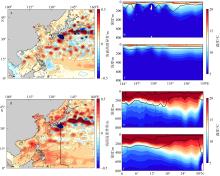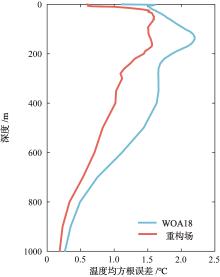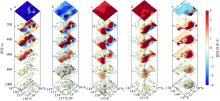Journal of Tropical Oceanography ›› 2025, Vol. 44 ›› Issue (5): 39-49.doi: 10.11978/2024226CSTR: 32234.14.2024226
• Marine Hydrology • Previous Articles Next Articles
Three-dimensional eddy structure reconstruction in the Northwest Pacific using variational method and satellite sea surface data
LI Lin1,2( ), WANG Xidong1,2(
), WANG Xidong1,2( ), HE Zikang1,2, CHEN Zhiqiang3, CAO Yuan1,2, LIU Kefeng4, CHEN Jian5
), HE Zikang1,2, CHEN Zhiqiang3, CAO Yuan1,2, LIU Kefeng4, CHEN Jian5
- 1. Key Laboratory of Marine Hazards Forecasting, Ministry of Natural Resources, Hohai University, Nanjing 210024, China
2. College of Oceanography, Hohai University, Nanjing 210024, China
3. South China Sea Institute of Oceanology, Chinese Academy of Sciences, Guangzhou 510301, China
4. College of Advanced Interdisciplinary Studies, National University of Defense Technology, Changsha 410073, China
5. 5 Room, Beijing Institute of Applied Meteorology, Beijing 100029, China
-
Received:2024-12-02Revised:2025-02-07Online:2025-09-10Published:2025-10-14 -
Contact:WANG Xidong -
Supported by:National Key Research and Development Program of China(2022YFE0106400); National Natural Science Foundation of China(62073332)
CLC Number:
- P731.27
Cite this article
LI Lin, WANG Xidong, HE Zikang, CHEN Zhiqiang, CAO Yuan, LIU Kefeng, CHEN Jian. Three-dimensional eddy structure reconstruction in the Northwest Pacific using variational method and satellite sea surface data[J].Journal of Tropical Oceanography, 2025, 44(5): 39-49.
share this article
Add to citation manager EndNote|Reference Manager|ProCite|BibTeX|RefWorks

Fig. 3
Spatial distribution of Argo data (a) and vertical temperature profiles of Argo observations, reconstructed field, and WOA18 monthly climatology for individual locations (b1—b10). (a) Shading represents sea surface height with red stars indicating Argo spatial locations; (b1—b10) Red solid lines: Argo observations; black solid lines: reconstructed field; black dashed lines: WOA18 monthly climatology"


Fig. 4
Observed data trajectories (a, d) and cross-sections of the reconstructed field versus observed temperature (b, c, e, f). (a) Trajectory of observed data in the Northwest Pacific from June 17 to 29, 2019 (black curve) and the mean sea surface height anomaly (SSHA) from satellite observations during the observation period (color shading); (d) trajectory of observed data in the Northwest Pacific from August 7 to October 10, 2022 (black curve) and the mean SSHA from satellite observations during the observation period (color shading); (b, e) observed temperature profiles; (c, f) reconstructed temperature profiles. In the cross-section plots, the black polylines represent the upper and lower boundaries of the thermocline"

| [1] |
戴玉玲, 张伟, 包畯, 2018. 热带西太平洋海域温跃层判别方法比较[J]. 海洋预报, 35(5): 17-24.
|
|
|
|
| [2] |
王喜冬, 韩桂军, 李威, 等, 2011. 利用卫星观测海面信息反演三维温度场[J]. 热带海洋学报, 30(6): 10-17.
|
|
|
|
| [3] |
|
| [4] |
|
| [5] |
|
| [6] |
|
| [7] |
|
| [8] |
|
| [9] |
|
| [10] |
|
| [11] |
|
| [12] |
|
| [13] |
|
| [14] |
|
| [15] |
|
| [16] |
|
| [17] |
|
| [18] |
|
| [19] |
|
| [20] |
|
| [21] |
|
| [22] |
|
| [23] |
|
| [24] |
|
| [25] |
|
| [26] |
|
| [27] |
|
| [28] |
|
| [29] |
|
| [30] |
|
| [31] |
|
| [32] |
|
| [33] |
|
| [34] |
|
| [35] |
|
| [1] | MA Yu, WANG Weiqiang, YOU Qinglong, XIN Hongyu. The evolution and energy characteristics of the Sri Lanka Dome* [J]. Journal of Tropical Oceanography, 2023, 42(5): 1-16. |
| [2] | YANG Yikai, ZENG Lili. Spatiotemporal characteristics of mesoscale eddies with transport capability of saline Kuroshio water in the northern South China Sea [J]. Journal of Tropical Oceanography, 2023, 42(3): 75-85. |
| [3] | LIU Shuang, JING Zhiyou, ZHAN Haigang. Predicting the mesoscale eddy in the tropical and subtropical ocean based on generative adversarial network model [J]. Journal of Tropical Oceanography, 2022, 41(5): 1-16. |
| [4] | ZHANG Xu, JING Zhiyou, ZHENG Ruixi, HUANG Xiaolong, CAO Haijin. Submesoscale characteristics of a typical anticyclonic mesoscale eddy in Kuroshio Extension* [J]. Journal of Tropical Oceanography, 2021, 40(6): 31-40. |
| [5] | Xiaowen ZHOU, Haijin CAO, Zhiyou JING, Guanghong LIAO. Anisotropy of submesoscale eddy in Kuroshio Extension based on high resolution ROMS output analysis [J]. Journal of Tropical Oceanography, 2020, 39(3): 10-18. |
| [6] | Xia WANG,Wendong FANG,Rongyu CHEN. Intra-seasonal variability of sea level anomalies and their propagation features in the northern South China Sea from 25 years of satellite altimetry data [J]. Journal of Tropical Oceanography, 2019, 38(3): 1-12. |
| [7] | HU Shuibo, CAO Wenxi, WANG Guifen, XU Zhantang. Using MODIS to track and monitor the impact of a cold eddy on the bio-optical parameters of surface waters* [J]. Journal of Tropical Oceanography, 2016, 35(3): 1-10. |
| [8] | TIAN Yongqing, HUANG Honghui, GONG Xiuyu, YU Shaomei. The formation mechanism of the low temperature and high salinity water mass near the Zhongsha Islands in the South China Sea in March 2014 [J]. Journal of Tropical Oceanography, 2016, 35(2): 1-9. |
| [9] | GENG Wu,HE Wei-hong,ZOU Xiao-li,XIE Qiang. A numerical study of effects due to mesoscale eddy induced by an idealized typhoon and the Kuroshio in the Luzon Strait [J]. Journal of Tropical Oceanography, 2013, 32(2): 66-73. |
| [10] | XU Chi, CHEN Gui-ying, SHANG Xiao-dong, HUANG Rui-xin. The spatial distribution of sources and sinks of ocean mesoscale eddies [J]. Journal of Tropical Oceanography, 2013, 32(2): 37-46. |
| [11] | WANG Xin, DU Yun-yan, ZHOU Cheng-hu, FAN Xing, YI Jia-wei. An improved, SSH-based method to automatically identify mesoscale eddies in the ocean [J]. Journal of Tropical Oceanography, 2013, 32(2): 15-23. |
| [12] | SHANG Xiao-dong, XU Chi, CHEN Gui-ying, LIAN Shu-min. Review on mechanical energy of ocean mesoscale eddies and associated energy sources and sinks [J]. Journal of Tropical Oceanography, 2013, 32(2): 24-36. |
| [13] | LIU Guang-ping,HU Jian-yu. A preliminary analysis of variation of the Kuroshio axis during tropical cyclone [J]. Journal of Tropical Oceanography, 2012, 31(1): 35-41. |
|
||















